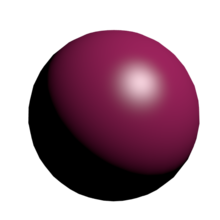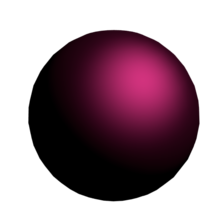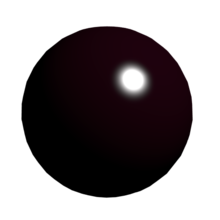Blender 3D:零基础到专业级-单元2:基本建模和着色
There are different kinds of shiny materials. Consider the difference between a shiny metallic object, and one made out of a glossy nonmetallic material (like plastic or ceramic). This page will explain some simple techniques for (approximately) mimicking the appearances of these materials using shader settings in the Blender Internal renderer.
::有不同类型的闪亮材料.考虑闪亮的金属物体和由光泽的非金属材料 (如塑料或陶) 制成的物体之间的区别.本页将解释一些简单的技术,用于 (大约) 模仿这些材料的外观,使用Blender内部染器中的影子设置.
For all the following manipulations, start a new Blender document, get rid of the default cube, and replace it with a UV sphere. Set it to be smooth-shaded. Change the lamp falloff to be inverse linear, just to make the scene brighter. Assign the sphere a new default material. It is the settings of this material we will now proceed to play around with.
::对于所有下列操作,启动一个新的混合器文档,删除默认立方体,并用UV球体取代它.设置它为光滑的阴影. 改变灯落为反向线性,只是为了让场景更亮. 赋予球体一个新的默认材料. 这是我们现在将继续玩弄的材料的设置.
Making It Plastic
::塑料制造

For a plastic or glossy effect, give the material a diffuse colour, but leave the specular colour at white. Increase the specular intensity to something like 0.9.
::为了塑性或光泽效果,给材料散色,但留下白色的镜面色.增加镜面强度到0.9左右.
(In this and the following examples, I used a diffuse colour of #E7398B.)
:在此和以下示例中,我使用了#E7398B的扩散色.)
Making It Metal
::让它成为金属

Now change the specular colour to be the same as the diffuse colour. (The easy way to do this is to bring up the specular colour picker, click on its eyedropper icon, and use the eyedropper tool to click on the swatch showing the diffuse colour.) Also lower the specular hardness from its default value of 50, to something like 25 or even 12. This will spread out the specular highlight, giving the impression of a surface that is shiny, but not perfectly smooth. Also lower the diffuse intensity, to something like 0.05.
::现在改变镜面颜色与扩散色相同. (简单的方法是带出镜面颜色选择器,点击其滴眼图标,并使用滴眼工具点击显示扩散色的样本.) 还将镜面硬度从默认值50降低到25甚至12. 这将扩展镜面亮点,给出光泽但不完全光滑的表面的印象. 还将扩散强度降低到0.05.
To make the metal more convincing, you may want to choose a more typical metal colour, like grey, copper or bronze.
::为了让金属更具说服力,
Making It Ceramic
::陶制造

Let’s try for a glazed-ceramic look, or perhaps some dark, shiny stone like obsidian. Set the specular colour back to white (the easiest way to do this is to switch to HSV view in the colour picker and set the S(aturation) value to 0). Increase the hardness to something like 200 to narrow and intensify the specular highlight. Leave the specular intensity high and the diffuse intensity low.
::让我们尝试一下玻璃陶的外观,或者可能是像木这样的黑色,闪亮的石头.将镜面颜色重新设置为白色 (最简单的方法是切换到颜色选择器中的HSV视图并将S{}和值设置为0).将硬度增加到200左右以缩小和加剧镜面亮点.保持镜面强度高,分散强度低.
To get an even more sharply-focused highlight, change the specular shader model from its “CookTorr” default to “WardIso”. The “Hardness” parameter gets replaced with a “Slope” instead; leave this at the default 0.1.
::为了获得更清晰的焦点,将镜像遮光器模型从默认的CookTorr变为WardIso. 硬度参数被替换为斜度参数,将其置于0.1的默认值.